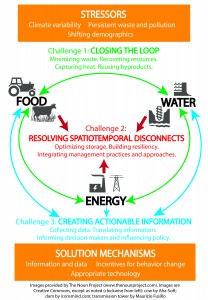In semi-arid regions, like the Western United States, the intertwined stressors of climate variability, persistent waste, continued pollution and shifting demographics are creating trilemmas in linked food, energy, and water (FEW) systems. The effects of these trilemmas are environmental, economic, and social. For example, on-going drought in California has reduced the availability of water for both renewable hydropower and agriculture. The resulting water-use trade-offs have left fields fallow, increased energy and food prices, and depleted groundwater supplies. To develop the science, technology, and policy to resolve trilemmas in FEW systems, University of California at Berkeley hosted the National Science Foundation funded Developing Intelligent Food, Energy, and Water Systems Workshop (DIFEWS) on September 28-29, 2015. The workshop brought together investigators in the physical, natural, computer, and social sciences, along with engineers, economists, policy-makers, and practitioners from diverse backgrounds.
The workshop identified three key challenges for FEW systems in California and beyond:
Challenge 1: Closing the Loop Across FEW Systems
There are many inputs and outputs of agricultural, water, and energy systems that should be designed and managed to minimize inputs, maximize outputs, and minimize provision inequality. Important research opportunities identified include: reducing edible food waste along the supply chain; capturing and reusing nutrients in organic waste products; recovering heat in the food sector; utilizing food waste and wastewater as sources of renewable energy; capturing waste water and tailoring treatment quality to targeted end use.
Challenge 2: Resolving Spatiotemporal Disconnects in FEW Systems
Supply and demand for FEW resources are largely uncoupled in time and space. Important research challenges identified include: optimizing storage in ever-lengthening food cold chains; development of small-scale hydropower technologies and necessary control systems to allow for distributed generation of electricity in the agricultural sector; developing better soil management techniques, creating distributed smart irrigation systems; developing the technology to increase groundwater storage by creating “frackquifers”; and encouraging institutions and enabling policies for the integrated management of FEW systems.
Challenge 3: Creating Actionable Information
FEW systems involve a variety of actors whose behaviors, decisions, and actions are impacted by economics, policy, information, social and cultural factors, and physical access to technologies and resources. Important research opportunities identified included: developing cyberphysical infrastructure and lifecycle methodologies to collect integrated information and data on food, energy and water and investigating ways to best translate FEW information to inform and influence a diversity of stakeholders.
Beyond the research challenges identified, fully understanding and ultimately managing FEW systems will require a combination of (i) discovery driven disciplinary science at the frontiers of the physical, natural, and social fields; (ii) integrative research that unites these disparate disciplines; and (iii) the training and formation of interdisciplinary teams.